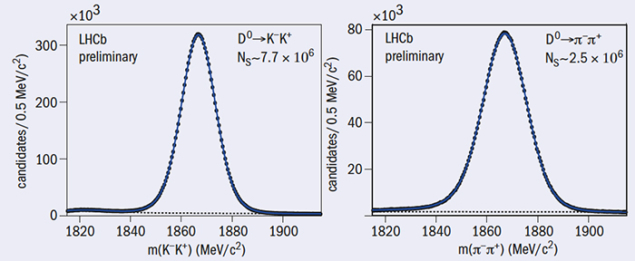
Owing to the large cross-section for charm production at the LHC, LHCb collected the world’s largest sample of charmed hadrons, allowing for stringent tests of the Cabibbo–Kobayashi–Maskawa (CKM) mechanism in the Standard Model (SM). The search for violation of the charge-parity (CP) symmetry in weak interactions is among the most relevant of such tests.

Image credit: LHCb Collaboration.
In recent years, LHCb confirmed unequivocally that CP violation occurs in the B0 system, and observed, for the first time, the same mechanism in B0s decays. All of the results match the SM predictions well. Although an outstanding experimental precision in the charm sector has been achieved, clear evidence of CP violation has not been seen yet. Mesons composed of a charm and an anti-up quark, so-called D0 particles, constitute an interesting laboratory for this search. The D0 meson is the only particle in nature containing an up-type quark that gives rise to the phenomenon of matter–antimatter oscillation.
In the SM, in contrast to the case of beauty mesons, the weak decays of charmed mesons are not expected to produce large CP-violating effects. However, CP violation can be enhanced by transitions involving new particles beyond those already known.
In 2011, LHCb reported the first evidence for CP violation in the charm sector, measuring the difference of the time-integrated CP asymmetries in D0 → K–K+ and D0 → π–π+ decays to differ significantly from zero, ΔACP = [–0.82±0.21 (stat.)±0.11 (syst.)]%. This result was reinforced later by new measurements from the CDF and Belle experiments. On the other hand, in 2014, LHCb published a more precise measurement, ΔACP = [+0.14±0.16 (stat.)±0.08 (syst.)]%, with a central value closer to zero than that obtained previously, with a precision of 2 × 10–3.
Now, using the full data sample collected in Run 1, LHCb breaks the wall of 10–3 for the first time ever, reaching a precision of 9 × 10–4. The measured value of ΔACP is [–0.10±0.08 (stat.)±0.03 (syst.)]%.
Although the evidence for CP violation in the charm sector is not confirmed, LHCb brings charm physics to the frontier of experimental knowledge. The experiment plans to collect an integrated luminosity of 50 inverse femtobarn, owing to an upgraded detector, in about 10 years from now. This will improve the precision of these results by an order of magnitude.







